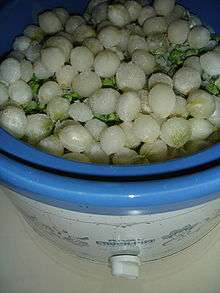Pearl onion

The "true" pearl onion (A. ampeloprasum var. sectivum or A. ampeloprasum 'Pearl-Onion Group')[1] is a close relative of the leek (A. ampeloprasum var. porrum), and may be distinguished from common onions by having only a single storage leaf,[2] similar to cloves of garlic. They are cultivated mostly in Germany, the Netherlands, and Italy; usually in home gardens, although formerly on a commercial scale. They are mostly used for pickling.[3]
However, the majority of onions grown for pickling are common onions (A. cepa).[4] They are grown to a small size suitable for pickling by planting at a high density.[5]
Because of its uniquely small size and a taste sweeter than that of a common onion, it has also been used in dishes ranging from mid-20th-century American casserole dishes such as succotash to sweetly flavored onion relishes in Indian cuisine. A pearl onion will take up to two years to become sufficiently sweet for sale (such is the main reason it is less popular in America than other onions). Pearl onions are, however, a staple to the cuisine of Northern Europe, especially Sweden.
Cultural references
Larry Wall's yearly serious State of the Onion speeches about advancements in Perl programming, an allusion to the many layers of the language, are named as a pun both on the pearl onion and the US presidents' State of the Union addresses.
References
- ↑ Fritsch, R.M.; N. Friesen (2002). "Chapter 1: Evolution, Domestication, and Taxonomy". In H.D. Rabinowitch and L. Currah. Allium Crop Science: Recent Advances. Wallingford, UK: CABI Publishing. p. 9. ISBN 0-85199-510-1.
- ↑ AVRDC - The World Vegetable Center. "Onion cultivation". Retrieved 25 April 2011.
- ↑ Hanelt, Peter (2001). "Alliaceae". In P. Hanelt. Mansfeld's Encyclopedia of Agricultural and Horticultural Crops (except ornamentals). Berlin: Spring-Verlag. p. 2266. ISBN 3-540-41017-1.
- ↑ Fritsch, R.M.; N. Friesen (2002). "Chapter 1: Evolution, Domestication, and Taxonomy". In H.D. Rabinowitch and L. Currah. Allium Crop Science: Recent Advances. Wallingford, UK: CABI Publishing. p. 20. ISBN 0-85199-510-1.
- ↑ Brewster, James L. (1994). Onions and other vegetable alliums (1st ed.). Wallingford, UK: CAB International. p. 212. ISBN 0-85198-753-2.
.jpg)